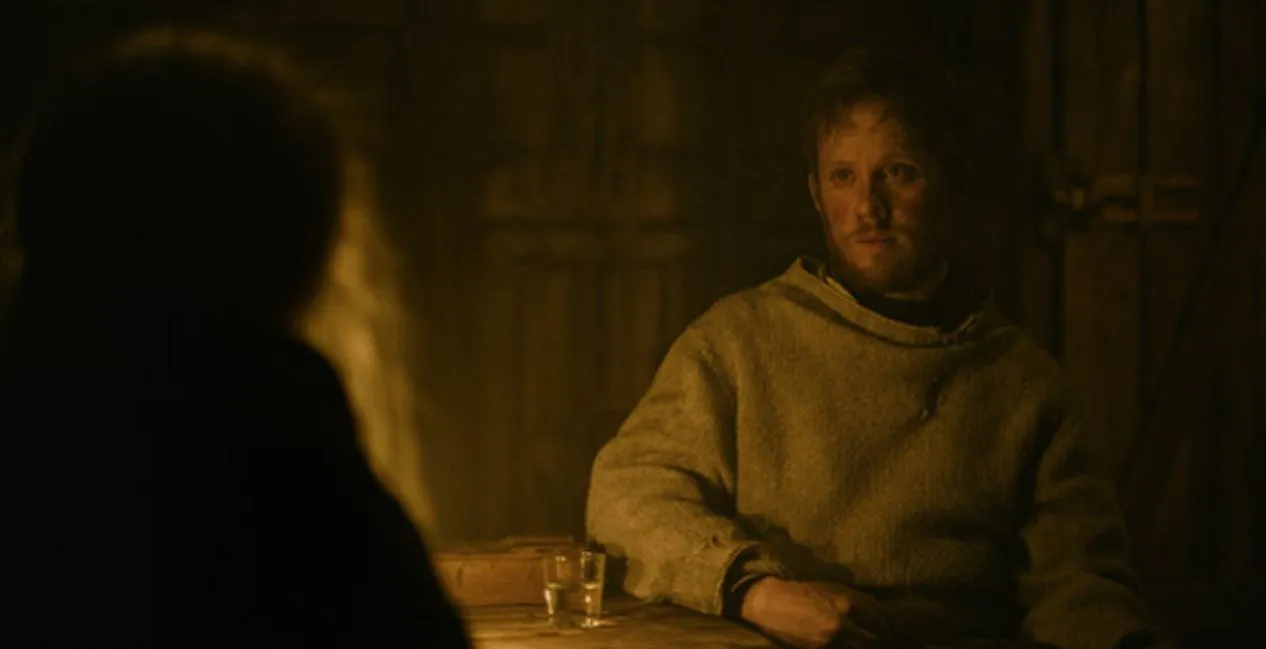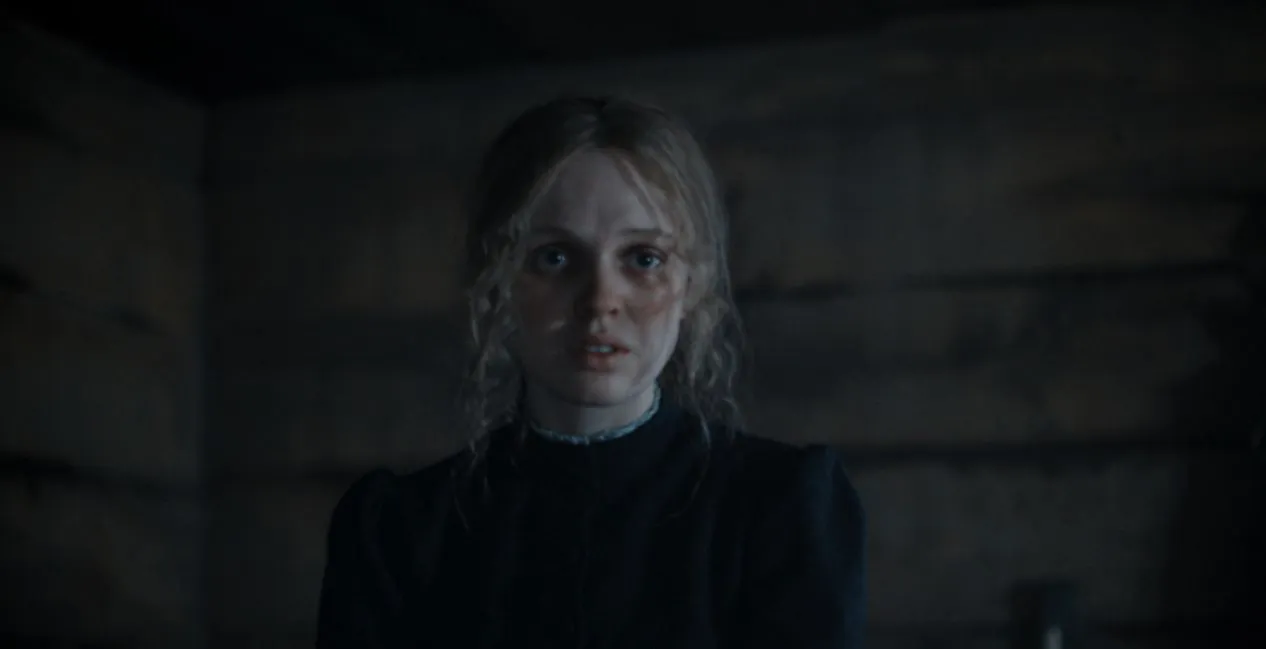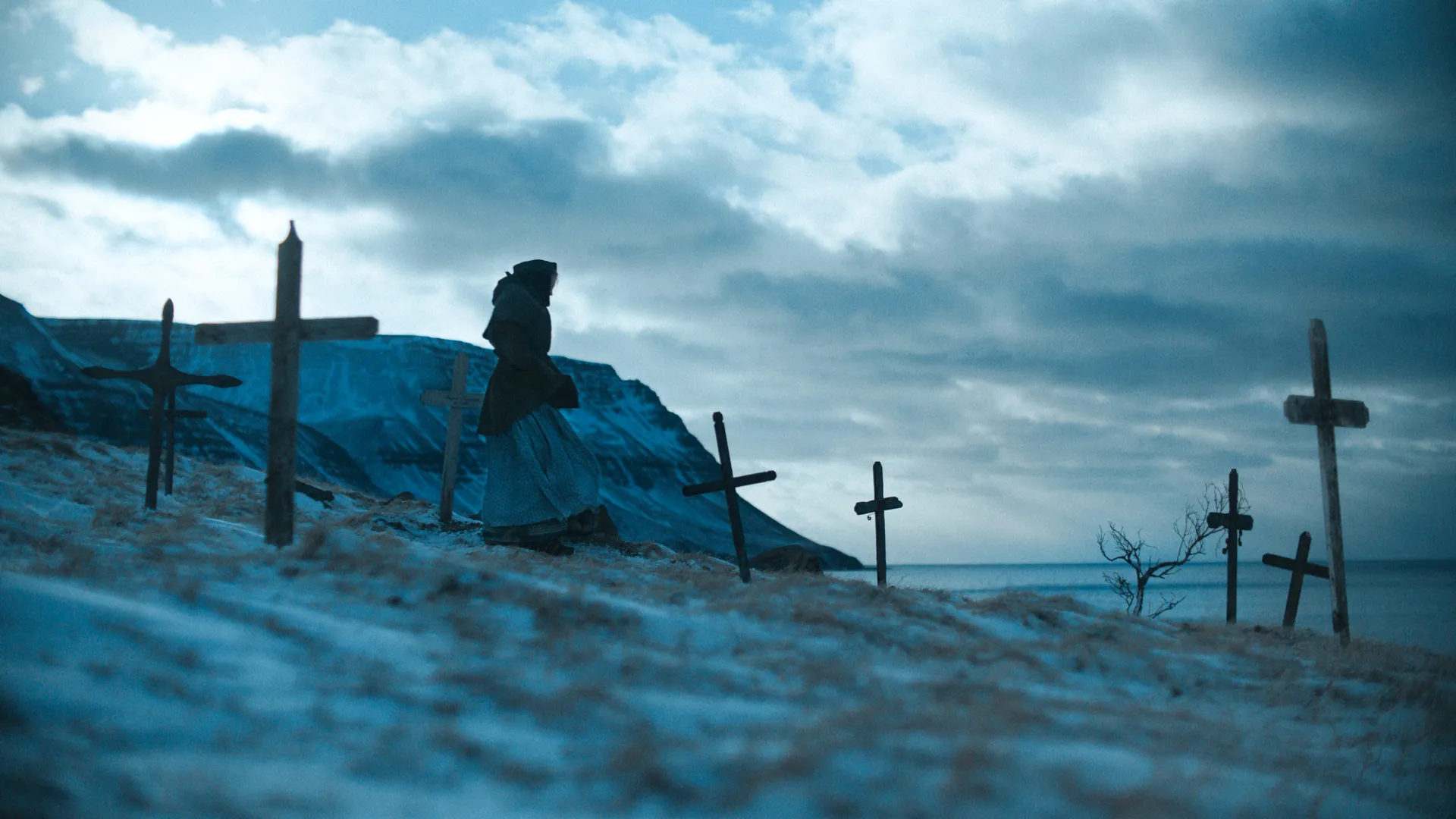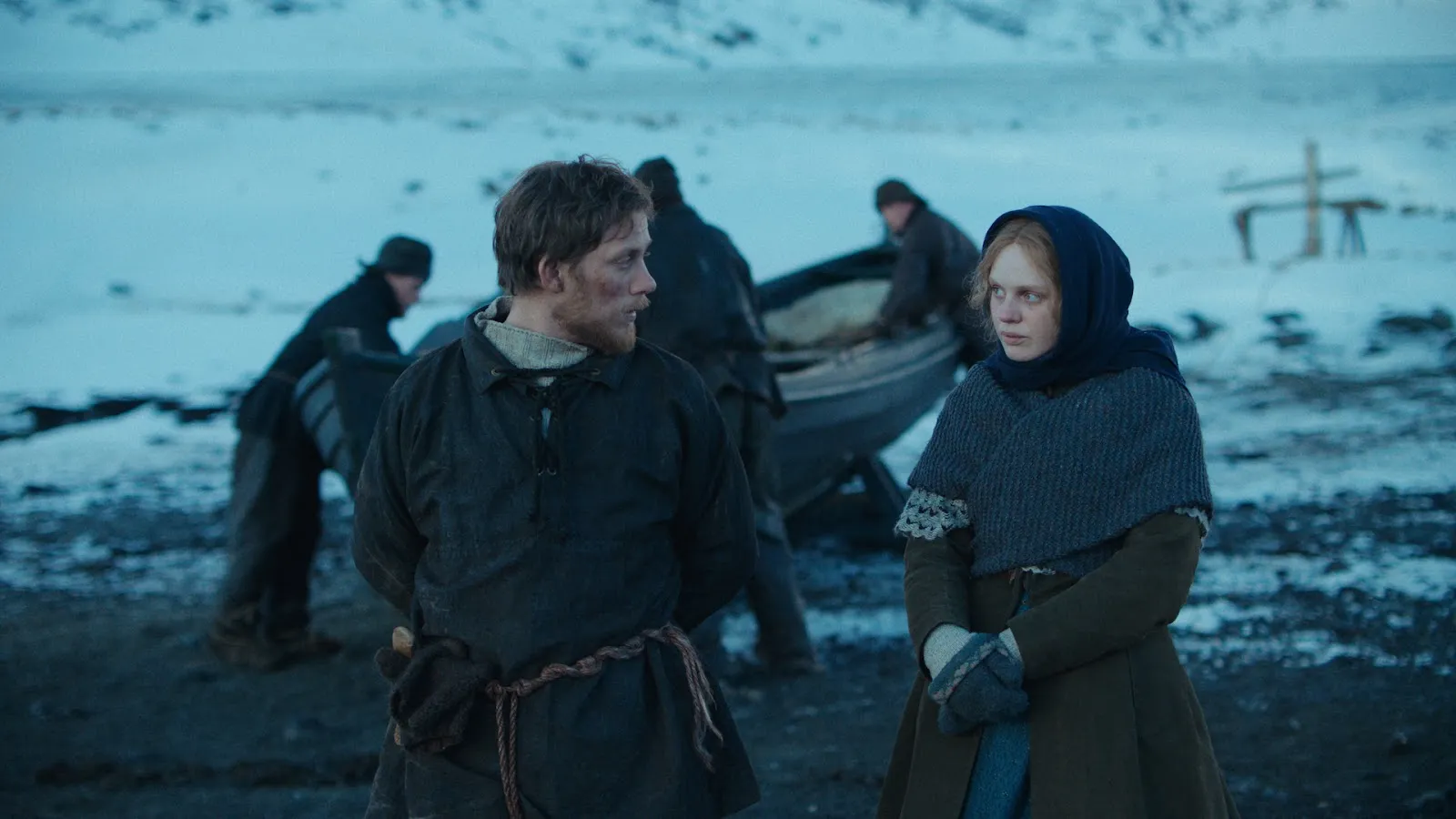The frozen Westfjords of Iceland serve as more than just a backdrop in The Damned; they are an ever-present character that shapes the very psyche of their people. With its sharp peaks and endless icy horizons, this barren landscape’s stark beauty evokes a sense of both wonder and dread. Here, nature is not just a setting but a relentless force that doesn’t care about human suffering—a stark reminder of humanity’s fragility.
The film’s main themes of survival and guilt are emphasized by the 19th-century setting steeped in isolation and suffering. The characters struggle with choices that echo the historical tensions of seafaring communities dealing with the harsh realities of nature (and perhaps, by extension, the unforgiving tides of societal expectations) as they are caught in their moral problems. As the weight of custom clashes with the urgency of survival, the period, with its limited technology and ingrained superstitions, further complicates their situation.
The character’s inner turmoil is mirrored in the harsh environment of this world, where every choice can lead to salvation or death. The howling winds and cold seas become a cacophony of guilt, reminding them of what they did wrong. It’s as if the landscape is working against them, a physical representation of their haunted minds, compelling viewers to ponder their fate, our relationship to the natural world, and the history we tend to forget.
The Weight of Leadership: Eva and the Burden of Choice
At the center of The Damned is Eva, a character whose life is already very complicated by the fact that she is a widow and a hesitant leader. In her role, Odessa Young perfectly captures the essence of a woman dealing with her past and navigating the (literal and figurative) dangerous seas of leadership.
She is torn between remembering her late husband and the urgent reality of survival, and the internal conflict she is experiencing is palpable. Her choices — or, more properly, the choices she feels compelled to make — echo the moral conundrums faced by historical figures in difficult situations, such as wartime leaders who must balance the needs of the few with the lives of many.
There is a tragic sense of inevitableness to Eva’s choices, which is a mirror of how society expects women to be both caring and determined. When motherly instincts and ruthless realism meet, it makes for a rich tapestry of emotional turmoil. Her struggle goes beyond the elements to the essence of who she is: can she be both a grieving widow and a strong leader? This question seems to resonate deeply in a world where personal grief is frequently pitted against social norms.
The supporting cast of fishermen embodies a microcosm of male friendship fraught with tension, further enriching the narrative. These guys, who have been through a lot in their lives, go back and forth between loyalty and rivalry, showing how their past traumas affect how they respond to Eva’s lead. Characters like Daniel (Joe Cole) are a flicker of hope and a possible romance, but their interactions are often steeped in a palpable tension that underscores the fragility of friendship in the most trying times.
The film deftly shows how people’s pasts and social roles can cause them to be at odds with one another as the men deal with their guilt and fears. Some turn to religion for comfort, while others resort to violence. It’s a haunting reflection on how isolation can mess up relationships and lead to collective madness.
The men’s interactions in this harsh environment offer a jarring commentary on manhood, survival, and the scars from their pasts that are often hidden. The viewer is invited to reflect on the larger implications of leadership, responsibility, and the lengths one will go by, contrasting Eva’s inner conflict with the fishermen’s external struggles.
Navigating Guilt and the Shadows of Folklore
Existential questions that echo throughout history are raised in The Damned, which expertly weaves themes of guilt and moral problems into its narrative fabric. The main choice—whether to save or leave the survivors of the shipwreck—is a pivotal point in the characters’ lives.
It’s a choice that sounds like something from seafaring history, where sailors often struggled with the weight of their moral duties. Here, Eva’s instructions to abandon the victims reflect a ruthless realism and serve as a sobering reminder that sometimes survival calls for making sacrifices.
The community is still feeling the consequences of this choice, manifesting as haunting ghosts of guilt that threaten to destroy their already fragile mental health. The psychological toll of leadership, where every choice could mean losing something forever, is starkly explored in this film. The film offers a sobering counter-narrative: sometimes the right choice is the one that feels the most wrong in a society that frequently idolizes the notion of courage. This moral complexity makes the viewer ponder their own moral limits—how far would they go to protect their own?
The addition of supernatural elements, especially the Draugur, underscores the film’s investigation of guilt. The sailors’ sins come to life in these undead figures that blur the line between reality and folklore. They are a constant reminder of the choices they made and the consequences they faced. The Draugur are not just monsters but also manifestations of guilt and grief, haunting the characters and forcing them to confront their past mistakes. This folkloric symbolism enhances the narrative by illustrating how myths can shape collective awareness and morality perceptions.
As the characters deal with these supernatural hauntings, they are forced to confront their inner demons, which reflect larger societal issues like guilt and responsibility that resonate in modern discourse.
The film cleverly suggests that folklore is not just a relic of the past but a live, breathing entity that shapes the present, reminding us that our personal and collective histories are inextricably linked to our choices. The Damned is not just a horror film; it is also a philosophical look at the human condition, asking the audience to reflect on their own stories of guilt and redemption through the interplay of guilt and folklore.
A Symphony of Shadows and Light
Filmmaker Eli Arenson creates a haunting and beautiful visual language for The Damned by using lighting and framing that creates both tension and closeness. The emotional isolation of the characters and the harsh Icelandic scenery has an interesting interplay.
One could almost call Arenson’s style “existential minimalism” because his camera often lingers on wide views where the characters are reduced to tiny dots against a harsh background. By purposely making the sense of fragility stronger, this choice makes the audience very aware of how precarious the characters’ situations are.
The lighting, which is often dim and flickering, evokes candlelight flickering against the darkness that is closing in, which is a metaphor for hope fighting against depression. Shadows lengthen, and the claustrophobia of the fishermen’s huts becomes palpable during increased tension. This visual technique shows a world where nature isn’t just a setting but an active participant in the drama, reflecting the characters’ inner struggles. The dance in the movie makes us think of the age-old conflict between man and nature, echoing historical narrative elements of survival against nature’s whims.
Along with its stunning visuals, the film’s sound design is very well done, adding to its creepy atmosphere. Stephen McKeon’s score is a haunting combination of strings and unsettling choral elements that feels old and new as if derived from the same folklore that runs through the narrative. The music builds and falls like the tide, reflecting the emotional ups and downs of the story while also giving the listener a sense of unease.
But the sound design does a great job of building tension. The sound of wood creaking, wind howling, and the echoes of horrors that can’t be seen form a tapestry of sounds that wrap around the viewer. There is a steady, unavoidable presence that makes the characters’ mental pain worse with each sound that reminds us of their isolation. It’s like the environment is working against them by strengthening their fears and regrets.
This careful attention to visual and aural detail is a commentary on our relationship to nature. The Damned reflects a disturbing truth: the very landscapes we live in can become sources of both beauty and terror in an age where human action is increasingly disruptive to the environment.
The film makes us think about how our own emotional or existential isolation can lead to haunting consequences, echoing past occurrences in which human hubris has caused destruction. The visual and sound design of The Damned does more than just set the mood; it also gives us a deep look into what it means to be human.
The Tides of Narrative: Plot and Pacing in The Damned
The Damned has a carefully planned plot that pulls the viewer right into its scary world from the start. The film’s story arc follows Eva as she struggles with her dual identity as a grieving widow and an unwilling leader, leading to a series of important events that change the course of the film and its haunting conclusion.
The finding of the shipwreck early on sets the stage for moral quandaries that echo through the ages. The tension rises as the fishermen argue about whether to save the person or themselves. This problem reflects larger societal issues about selflessness and survival (historical echoes of lifeboat ethics, anyone?).
The moments that turn things around—when Eva decides not to save them and when the Draugur shows up—are expertly planned. The characters feel increasingly guilty with every choice because it leads to a web of consequences. This buildup to the climax serves as a commentary on human nature, illustrating how desperate choices can lead to harm that cannot be fixed. Making the audience acutely aware of the fragility of morality in extreme situations, the narrative skillfully balances individual stakes with collective effects.
The film has a slow buildup of tension that is reminiscent of old-school psychological movies when it comes to pacing. This slow pace lets the characters really come to life, positioning the audience to feel the weight of Eva’s choices alongside her. Even though they are powerful, the moments of action are often juxtaposed with quieter, more reflective scenes. This contrast creates a rhythm that raises tension: the audience is lulled into a false sense of security, only to be shocked in a real way.
That said, this pacing creates some contradictions. The slow build creates a sense of impending doom, but viewers used to faster-paced horror tales may find it difficult to maintain their attention. However, The film’s genius lies in its insistence that the audience endure discomfort and reflect on their reactions to fear and moral ambiguity.
In the end, The Damned’s pacing serves as a microcosm of the human experience as a whole: how we deal with crisis moments, the decisions we make when we’re under pressure, and the haunting specters of regret that follow. The film’s methodical approach may resonate as a moving reminder of the power of reflection in the middle of chaos in a world where change happens quickly and people’s attention spans are short.
Haunting Echoes: The Cultural Context of The Damned
The Damned is steeped in Icelandic folklore, especially the story of the Draugur, who are undead creatures that represent the angry souls of sailors who perished at sea. The narrative is enhanced by this mythological layer, which turns the film from a simple horror story into a deep look at guilt and consequences. The Draugur are more than just ghosts; they represent the weight of unresolved wrongs, manifesting the idea that our past choices can come back to haunt us.
Cultural elements like these give the film a sense of authenticity, transporting the viewer to a world where old beliefs and contemporary problems coexist. Folklore serves as a lens through which the characters’ struggles are magnified, illustrating that both personal and communal ghosts of the past are unavoidable.
Also, The Damned brings up important issues in society, especially when it comes to survival ethics in difficult environments. Eva and her team had to make a very hard choice, which is similar to real-life situations where people often have to make life-or-death decisions. Do we protect our own lives at the expense of others, according to this notion of survival?—is a question that connects people from all different backgrounds and times.
The roles of men and women are also very important. By positioning a woman in authority among a sea of tough men, Eva’s leadership challenges historical norms. Her struggle for respect and her ability to move through spaces that are usually associated with men reflect larger social changes and ongoing discussions about gender roles.
Her character challenges the stereotypes of femininity in crisis, forcing us to reevaluate the relationship between gender and authority in historical and contemporary settings. In a world where survival frequently depends on leadership and decisiveness.
Echoes of Guilt and Resilience
The Damned turns out to be a haunting meditation on guilt, survival, and the difficulties of lead. The emotional and psychological weight it gives viewers makes it so effective, in addition to its spooky narrative. The film lingers, making the audience confront unsettling truths about their own moral choices.
The specter of regret and the struggle for authority in a male-dominated field are among the themes that resonate long after the movie is over.
The haunting presence of the Draugur and other vivid imagery strongly warns that our pasts are never really behind us. The Damned feels strangely pertinent in a time full of moral conundrums.
The Review
The Damned
The Damned is a masterful look at guilt, survival, and the haunting effects of the choices we make. It does a great job of combining Icelandic folklore with modern moral problems. Its arresting visuals and evocative sound design heighten the narrative's emotional depth, luring viewers into a world where every choice has weight. The film makes a powerful commentary on the human situation through the lens of Eva's struggles, challenging conventional ideas of leadership and gender dynamics.
PROS
- Stunning visuals that enhance the narrative.
- Deep exploration of guilt, survival, and leadership.
- Strong incorporation of Icelandic folklore.
- Leaves a lasting impression on viewers.
- Engaging character portrayals, particularly Eva.
CONS
- Slow burn may frustrate some viewers.
- May require multiple viewings to fully appreciate.
- Some may find the lack of traditional horror elements lacking.





















































